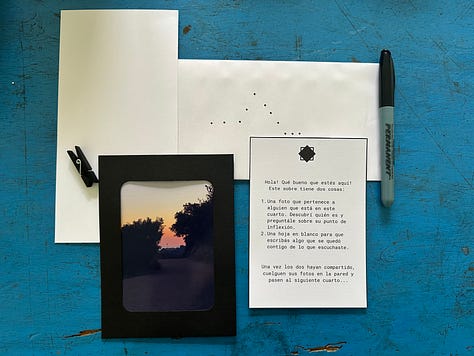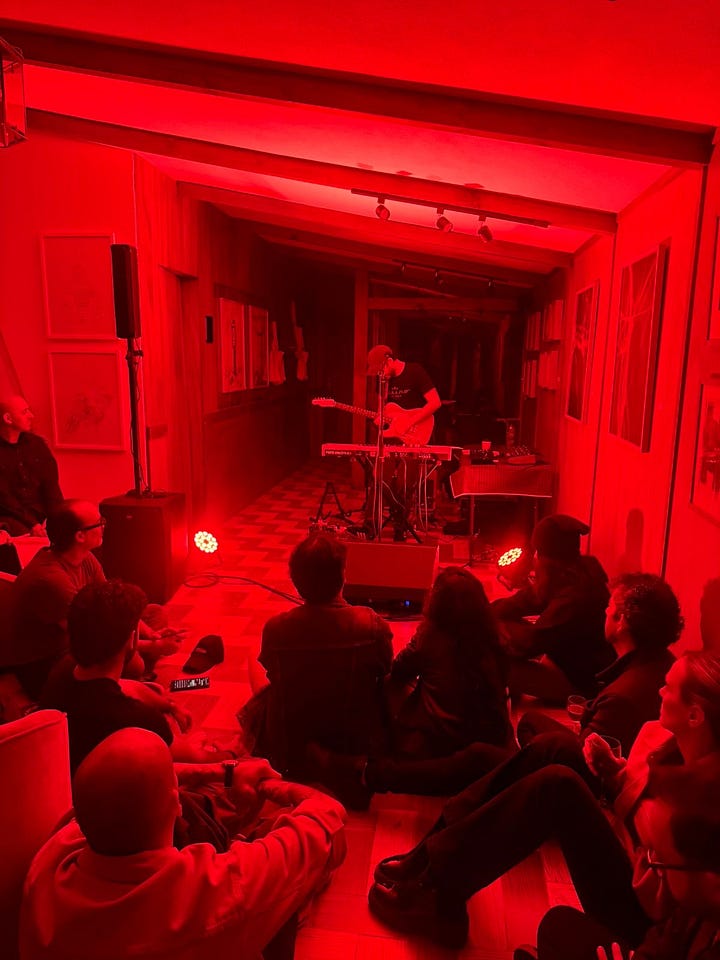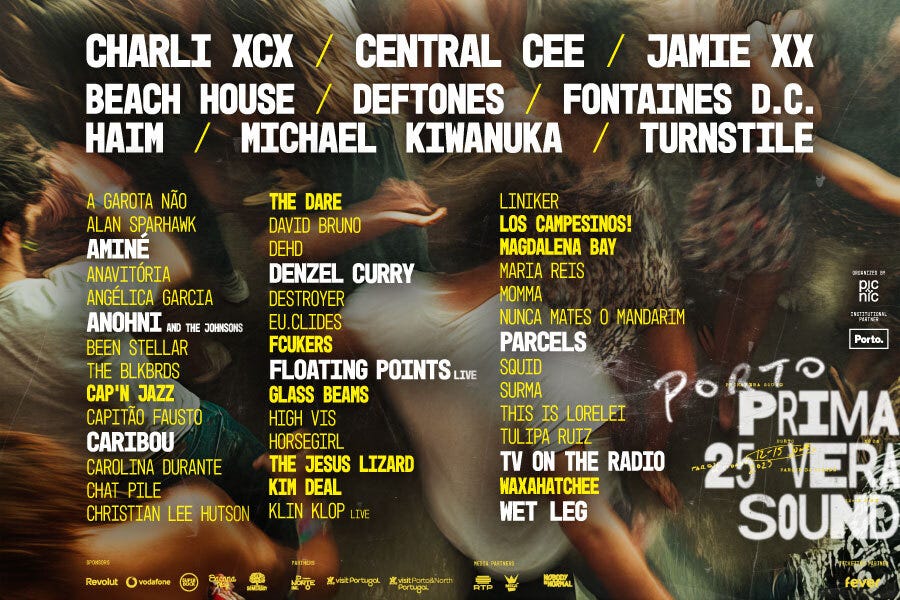Music, experiments, and risk
Designing experiences around creative artifacts
The first music festival we went to together was Primavera Sound in Porto. It felt alive. Unpredictable. A little risky. Looking back, those are the some of the ingredients that give shape to our little family: music, experiments, and risk.
When Fer asked me to co-design the experience for his new album pre-release, I knew we had to bring in the things we love most. This post is about the format we created, and what we learned from it. Designing an experience around a creative artifact is the format we’re exploring today.
📰 What’s the format?
Part concert, part encounter, this was a music show accompanied by a personalized experience. Fer’s new album, Punto de Inflexión (Inflection Point) is coming out soon, and we wanted to try something different… As we were thinking about it, we wanted to make sure we 1) created a space for guests to connect with each other; 2) find a way to make the experience feel personal and special; 3) allow guests to enjoy the music without the usual barrier between artist/audience. This was the final flow:
We curated a list of 30 guests and sent each of them a personal invitation including a letter written by Fer. In the letter, we asked them to upload a photo representing an inflection point in their life; something they felt comfortable sharing with others.
When guests arrived on the day of the event, they received an envelope containing: someone else’s photo, a pen and paper, and a card with simple instructions.



Their task: search and find the person whose photo they received, ask about their inflection point, and write down what stayed with them. (By design, each pair had each other’s photo.)
Once both had shared, they were invited to hang the photos on the wall, and then step into the next room, where Fer was getting ready to begin his set.
🎛️ What are the features?
In this article, Ida Benedetto describes some of the elements that make an experience transformational. Let’s explore a few of them:
The magic circle: Our goal was to create a moment of transition from everyday life into this shared space. As they step in the venue (a beautiful gallery in Guatemala City called House Guest),the lighting, welcoming people with a mysterious envelope, and the background music, helped people cross into the experience.
Risk: Asking strangers about inflection points (and sharing theirs) takes courage, and that’s where the connection began. Often, experiences that claim to be transformational fall short because they strip out too much worthwhile risk…
The structure: We designed it like a 3-act play. Arrival. Performance. Return (this time with a regained definition of inflection points and a sense that you knew everyone on the room a little more…)


A window separates the different spaces in the venue Transformation. This is a tricky one. It’s hard to define and even harder to measure. But one thing I’m learning is that transformation happens when the experience feels personal. That night, we heard things like:
“My inflection point brought me here.”
“Thanks for the inspiration. I deeply needed it.”
“Seeing our physical pictures made me feel special and seen.”
“We realized our inflection points had some similarities…”Maybe transformation is that subtle feeling that you’ve just seen yourself (or someone else) more clearly. That you’ve shared something that shifted how you relate to the world, even just a little…
As part of my Experience Design residency program,
and I have been exploring the concept of aliveness. What it means to feel fully present, engaged, and open to something unfolding. Even though we’re just beginning to scratch the surface, this event felt like a living case study. It had that vibe: a blend of vulnerability, surprise, and connection. It gave me a sudden electrical charge (which is why I ran to write about it the next day!)💡 Why is this format effective for learning?
This wasn’t designed as a “learning” experience. But it taught us a lot about connection, risk, and transformation. Maybe that’s the kind of learning we need more of.
Not content-first → but connection-first
Not teacher-led → but co-created
Not just structured → but spacious
💌 Lessons learned + an invitation
Here are some of my lessons learned:
People crave connection. Especially the kind that feels earned, not forced.
The right people will say yes.
There’s always someone willing to experiment and play (if you invite them with care…)Artifacts are portals.
Albums, books, and films are opportunities to gather, reflect, experiment, and play.Transformation starts with feeling.
People will remember feeling seen, curious, connected, part of something…Short and simple is better.
The impulse is to add. But the power often lies in what you subtract.Narratives matter.
Worldbuilding is the scaffolding that holds an experience together.It’s about them, not about you.
It’s not often that you attend an artistic show where you are the protagonist. Fer’s performance was stellar. And it was even more meaningful because the audience became a part of it.
What if you took something you’ve made and treated it like an artifact worth gathering around? Try building a little world around it. Add just enough risk to spark connection. Strip away the extras until what’s left feels personal.
What kind of experience might unfold? And who might walk away changed…?
🪁 Life Lately
We’re heading back to Primavera Sound for the third time in just a few weeks! In past years, we’ve seen The War on Drugs, Nick Cave, Grizzly Bear, Four Tet, and Gorillaz. This year, I’m especially excited for Fontaines D.C., Caribou, Michael Kiwanuka, Beach House, Parcels, Destroyer, HAIM, and Jamie XX.
Thanks to Naive Weekly, I joined the Sharing Screen with Laurel Schwulst event and left inspired! My kind of rabbithole, for sure. (Passes for future editions can be found here). Here’s Laurel’s website and her Are.na.
I appreciate your time. Thank you for reading! 💙 I also value your feedback (suggestions, critiques, constructive ideas…) as well as your tips or suggestions for future editions. I’d love to hear about you in the comments.
→ Or just click the heart symbol. That always makes me smile :-)
*This post’s gif is from @willkim
















